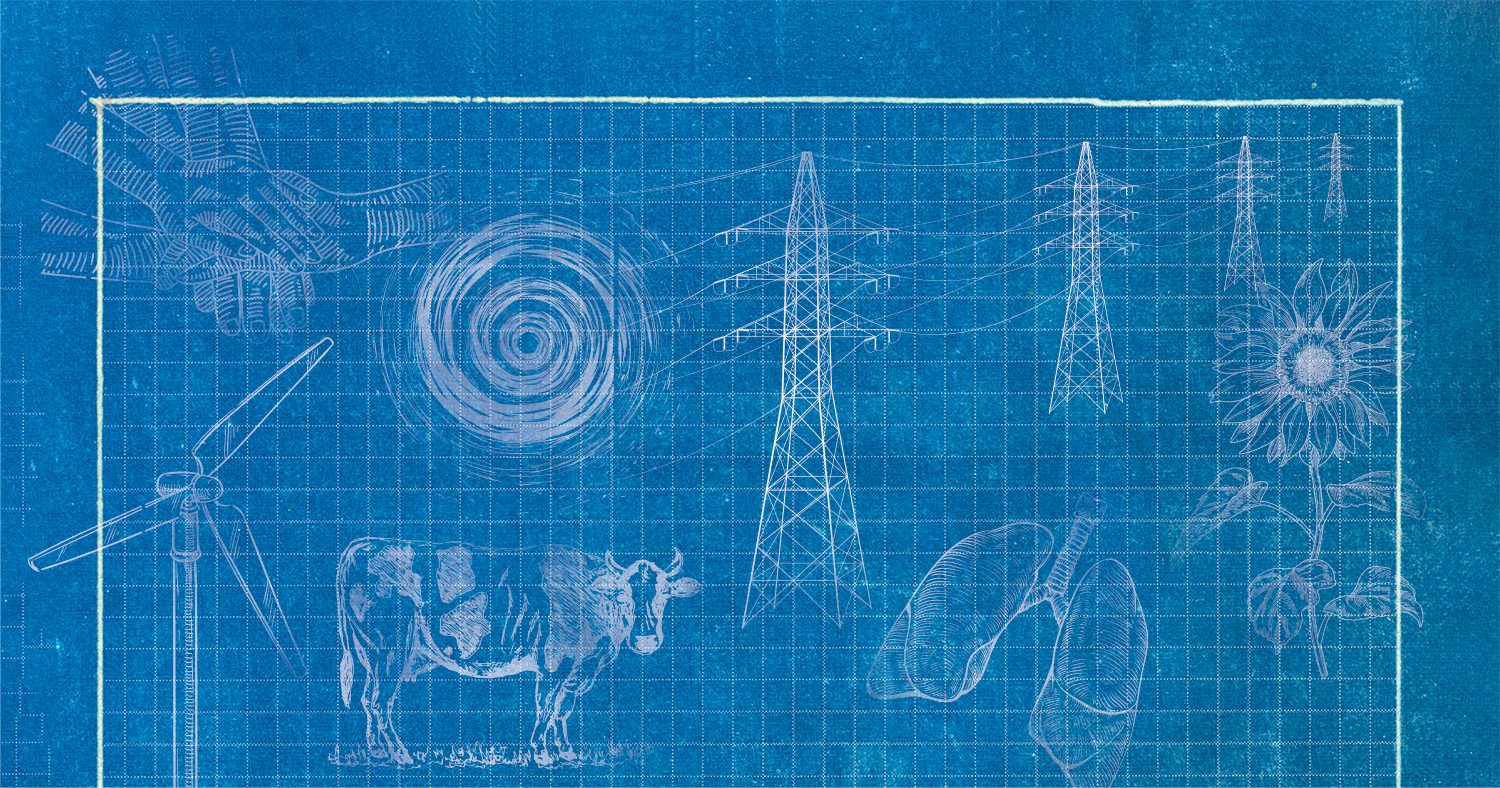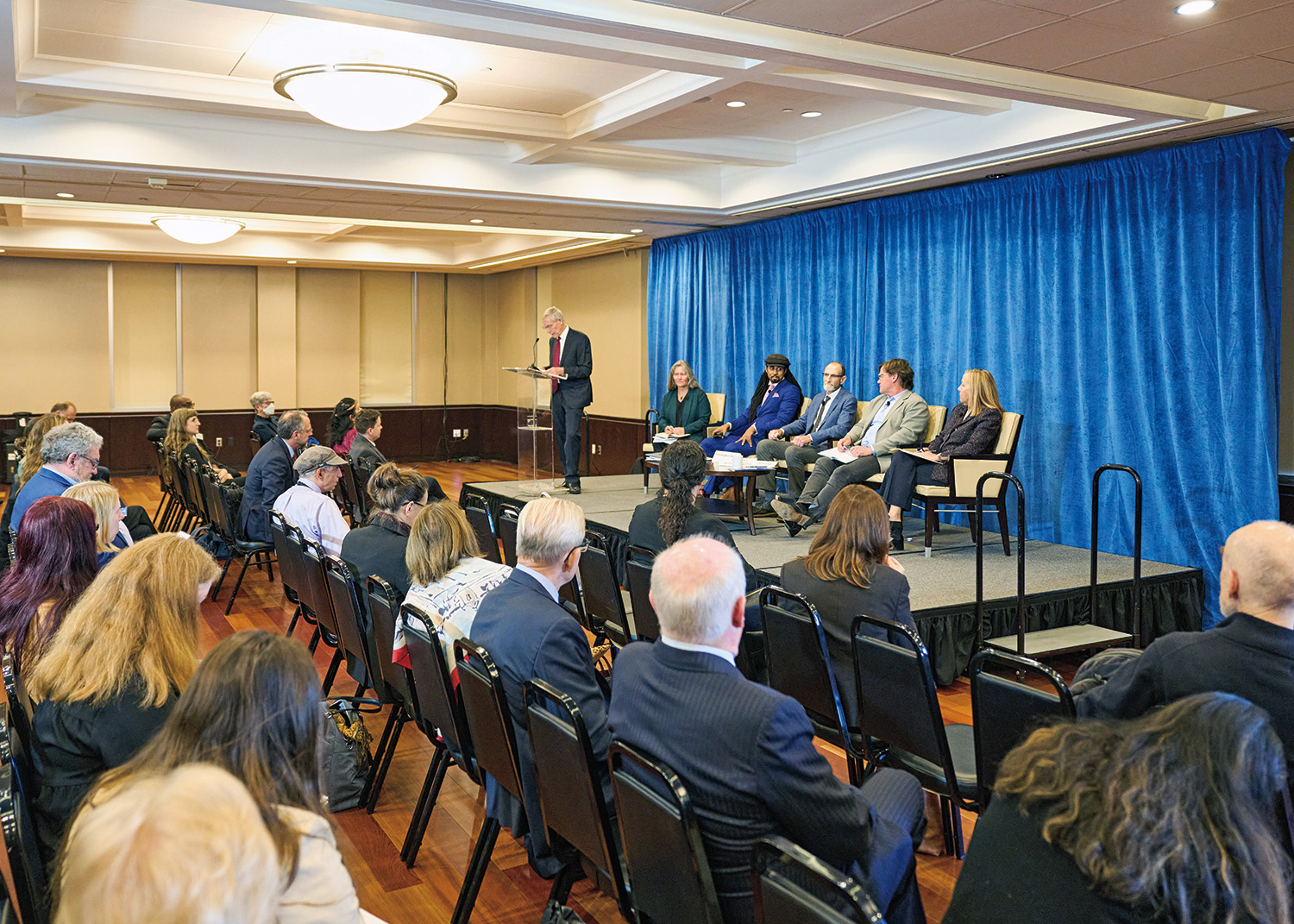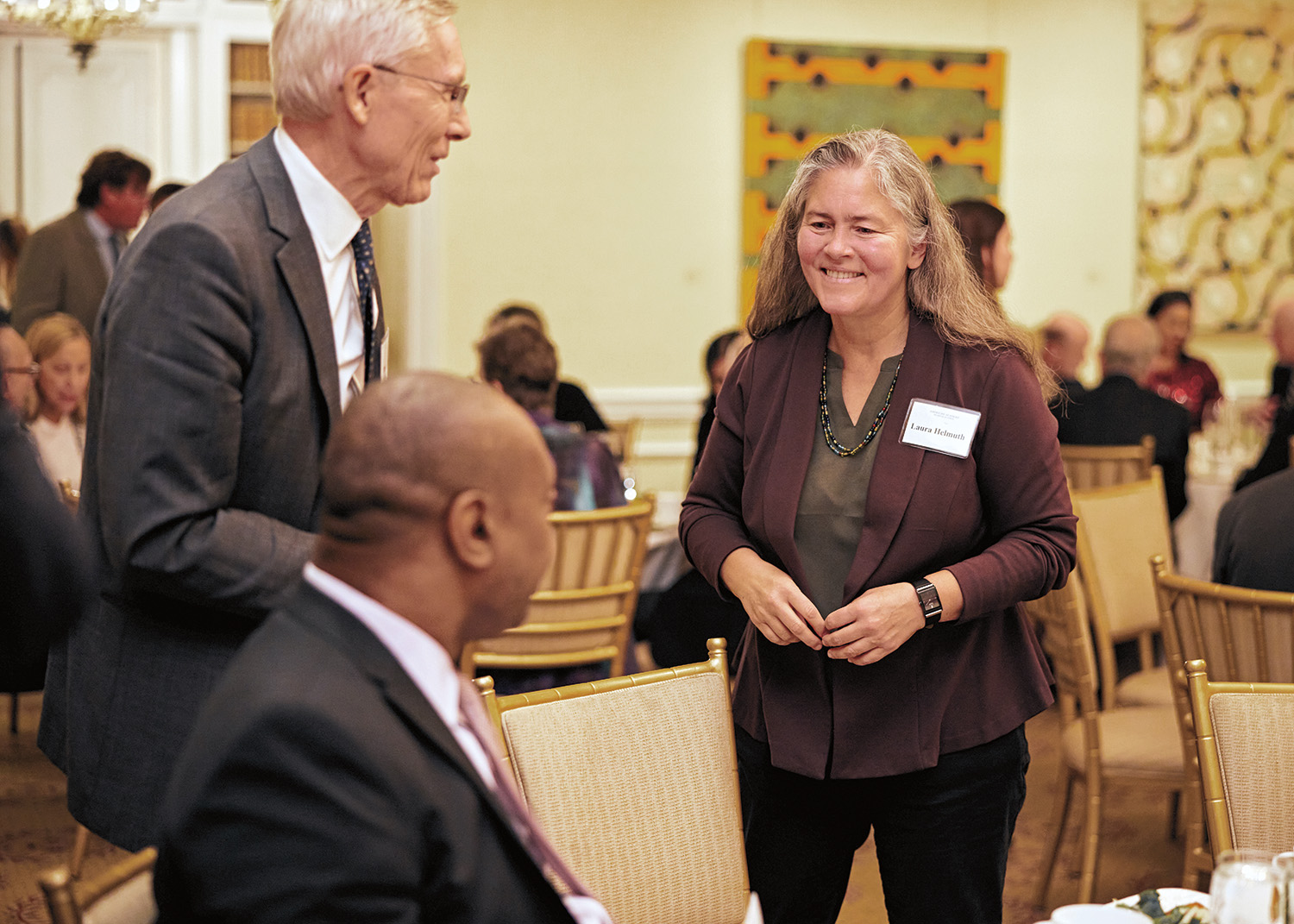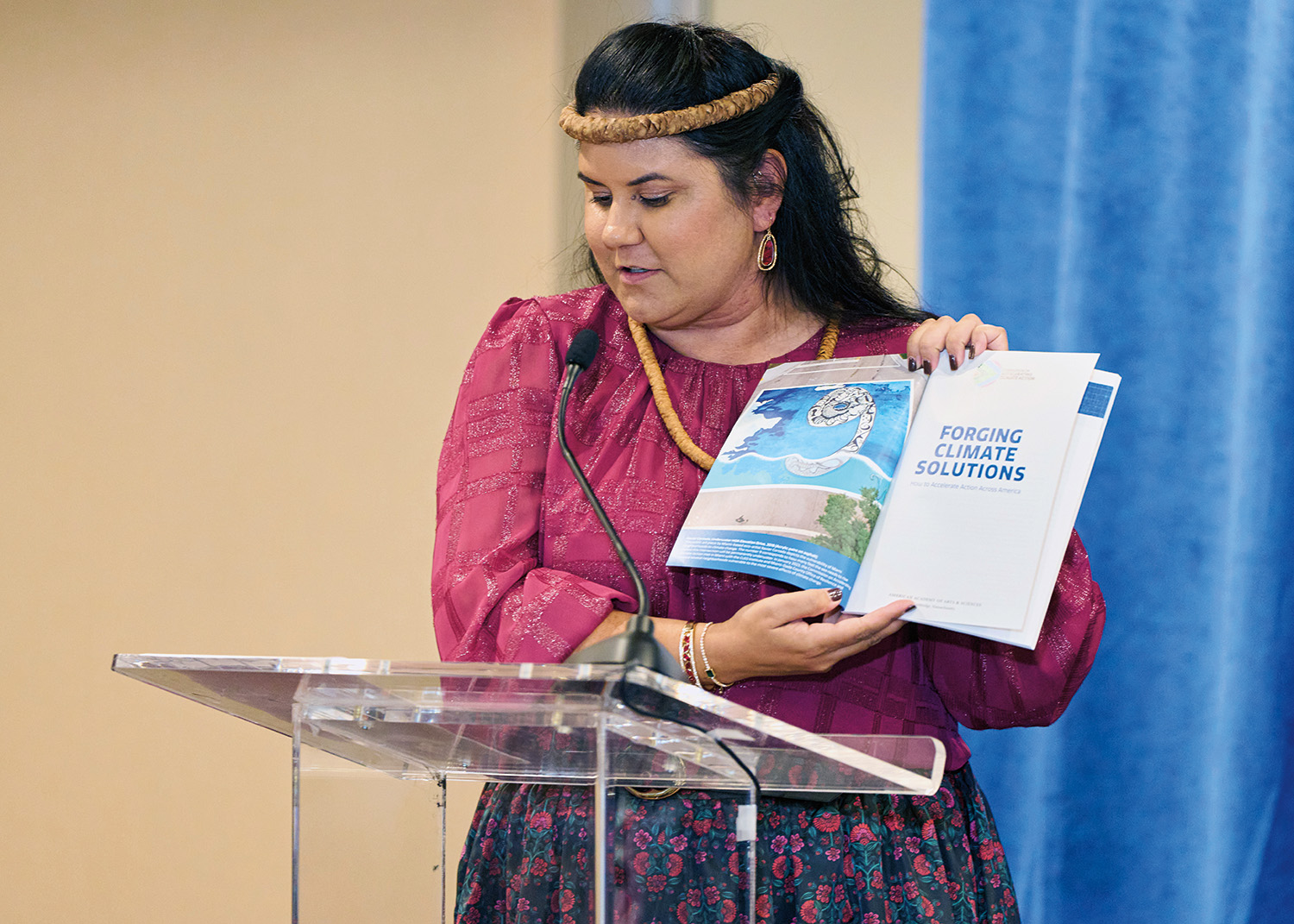By Carson Bullock, Program Associate for Science, Engineering, and Technology
On October 24, 2023, the Academy released Forging Climate Solutions: How to Accelerate Action Across America, the final report of the Commission on Accelerating Climate Action. Prompted by a statement by the Academy’s Board in 2021, the report addresses the need for a climate strategy that breaks through the divisions that characterize politics in the nation today.
The launch of Forging Climate Solutions included several events that highlighted the report’s key messages: a dinner for Academy members, a meeting with environmental nongovernmental organizations, and briefings with the federal government. Commission members spoke with representatives from the National Resources Defense Council, World Wildlife Fund, National Audubon Society, the U.S. Environmental Protection Agency, and the White House Office of Science and Technology Policy. Commissioners also met with several congressional offices, from both major parties and both chambers.
To celebrate the release of Forging Climate Solutions, Laura Helmuth (Scientific American) moderated a panel discussion with the Commission’s cochairs: Mustafa Santiago Ali (National Wildlife Federation; Revitalization Strategies), Christopher Field (Stanford Woods Institute), David G. Victor (University of California, San Diego), and Patricia Vincent-Collawn (PNM Resources). Helmuth introduced the report as “hopeful, clear, urgent, actionable, and inclusive” and engaged the cochairs in a discussion about the report’s guiding principles and recommendations.
The cochairs also spoke about the formation of the Commission and how, for many of the thirty-one Commissioners, the work of the Commission was very different from other projects that they had participated in. As noted in a white paper released by the Commission’s working group on communication, historically scientific messaging alone has not been enough to spur action, especially in the face of declining trust in science and rising opposition to perceived elites. And so the Commission set out to create a whole-of-society plan to combat the climate crisis.
The Commission was clear that its work and final report would not contain a silver bullet to address the climate crisis, and doubted if there ever would be one. Rather, the Commission articulates a “fair bargain” on climate change, which details how durable, interdisciplinary coalitions can be built across ideological divides. The fair bargain is just, but it is also pragmatic by bolstering political will for climate action. David Victor remarked at the report launch, “That’s how we’re going to show the fair bargain is actually delivering benefits. It’s building things, and building things in a way that generates more of the benefits locally, particularly in frontline communities.”
Like all Academy commissions and projects, the Commission on Accelerating Climate Action has a diverse membership. As Christopher Field noted during the panel discussion at the report launch, “We went out very explicitly to build a group that was more diverse than certainly any other climate group that I’ve been associated with,” a sentiment shared by several Commissioners. The Commission members have expertise in the arts and sciences but also in environmental justice, youth activism, Indigenous people and Indigenous Knowledge, public health, and urban design. “We looked very long and hard to make sure we had that wonderful collection of individuals that could rise above their personal differences to agree with the fabric of what we designed,” said Patricia Vincent-Collawn. The cochairs highlighted in particular the contributions of Commission member Rev. Mitch Hescox (Evangelical Environmental Network) and his attendance at the launch event, recognizing the important role of faith communities in communicating climate impacts.
In keeping with the diversity of the Commissioners’ contributions, Forging Climate Solutions is organized into five strategies. Each strategy contains three to five recommendations, tailored to a range of audiences, that highlight a different facet of building, sustaining, and accelerating climate action.
STRATEGY 1: Prioritize Equity, Fairness, and Justice in Climate Action to ensure that strategies lessen, not exacerbate, harm by focusing on those who will suffer from the consequences of climate change, energy transition, and adaptation efforts.
STRATEGY 2: Engage and Educate Diverse Communities to shift climate change communication from an elite, science-focused endeavor to one led by credible voices from diverse communities.
STRATEGY 3: Mobilize Investment to unleash the immense capital of the public and private sectors needed to cut emissions and make society more resilient to the impacts of climate change.
STRATEGY 4: Deploy Diverse Options for Controlling Emissions to send clear market signals to investors to accelerate mitigation across all sectors.
STRATEGY 5: Ensure Adaptation at All Levels of Society to protect vulnerable communities, respond to disasters, and enhance national security, which will require vast resources, coordination, and planning at the federal, state, and local levels.
The breath of the report’s scope required Commissioners to learn from one another and build a shared language across their disciplines. For example, as the Commissioners developed their recommendations, they learned how different constituencies interpret words like justice, fairness, and equity. “Words are on-ramps,” Mustafa Santiago Ali said of the importance of language, “so you can create words that stop folks from entering into a process, or you could make sure that folks see themselves reflected in the language. And being able to navigate that to make sure that the vast majority of our country sees themselves—it took work, but it was worth the investment.” Building consensus on the Commission, as a microcosm of American society, required the same trust-building, patience, and, at times, compromise that climate action will need.
With the report and launch events completed, Commissioners are now sharing the findings and recommendations with other key audiences. In addition to congressional outreach, which has continued virtually in the months following the launch, and planned events for Academy members around the country, project staff are expanding the report’s reach to less traditional audiences, such as industry groups. The report was recently highlighted at a press event at the American Geophysical Union’s fall meeting and featured at a workshop at the American Association for the Advancement of Science Annual Meeting in February 2024.
The Commission on Accelerating Climate Action is made possible through the generous support of Roger Sant and Doris Matsui, Hansjörg Wyss, Bob Higgins, the Grantham Foundation for the Protection of the Environment, William and Helen Pounds, the David and Ellen Lee Family Foundation, the Alfred P. Sloan Foundation, and an endowment provided by John E. Bryson and Louise Henry Bryson.
Summary of Recommendations
Strategy 1: Prioritize Equity, Fairness, and Justice in Climate Action
Recommendation 1.1
Prioritize investment in communities that are on the front lines and are the hardest hit by the consequences of climate change, energy transition, and adaptation efforts.
Recommendation 1.2
Build capacity for climate action by engaging diverse voices, removing barriers, and disseminating promising practices.
Recommendation 1.3
Weave frontline communities and Indigenous Knowledge into research on controlling pollution and managing the impacts of climate change.
Strategy 2: Engage and Educate Diverse Communities
Recommendation 2.1
Empower diverse and trusted messengers to communicate climate change issues that resonate with specific communities.
Recommendation 2.2
Support and celebrate concrete commitments to climate action by government, businesses, community groups, and NGOs.
Recommendation 2.3
Combat climate misinformation in the news and across social media.
Recommendation 2.4
Expand access to climate education across K–16 subjects and into formal and informal education venues. Advocate for climate education in all state curricula and develop tools for knowledge assessment.
Strategy 3: Mobilize Investment
Recommendation 3.1
Design, implement, and iteratively evaluate policies to push the technological frontier.
Recommendation 3.2
Leverage investments in infrastructure modernization to correct historical underinvestment in marginalized communities.
Recommendation 3.3
Create more robust, credible, and comprehensive incentives to retire and replace high-emission facilities and vulnerable infrastructure.
Recommendation 3.4
Redesign permitting processes to be less burdensome and more trustworthy.
Recommendation 3.5
Strengthen the mandate for companies to measure and disclose climate-related physical and transitional risks that are auditable, replicable, and material.
Strategy 4: Deploy Diverse Options for Controlling Emissions
Recommendation 4.1
Implement a fair carbon price in conjunction with other policies to create strong demand for low-emission technologies.
Recommendation 4.2
Cooperate with international allies to realign trade rules in favor of emissions reductions and make supply chains more resilient.
Recommendation 4.3
Advance efforts to control non-CO2 greenhouse gases and climate-warming aerosols, especially pollutants that have large impacts on human health and the environment.
Recommendation 4.4
Incentivize farmers and other landowners to decrease greenhouse gas emissions and increase carbon sequestration.
Recommendation 4.5
Support effective nature-based climate solutions.
Strategy 5: Ensure Adaptation at All Levels of Society
Recommendation 5.1
Spur increased investment in comprehensive adaptation plans through co-development with the federal government, states, tribes, cities, companies, and NGOs, including justice-centered voices from civil society.
Recommendation 5.2
Improve coordination and accessibility of existing climate resources and investments across federal agencies.
Recommendation 5.3
Invest in a diverse portfolio of adaptation options, including both responses to specific threats and broad commitments to building resilience.
Recommendation 5.4
Identify and eliminate perverse incentives, such as subsidies for hazard insurance, that have impeded efforts to understand and respond to climate-related risks.
The launch event was recorded and may be accessed at the Academy’s website. Forging Climate Solutions and more information about the Commission on Accelerating Climate Action are available at www.amacad.org/climate.



